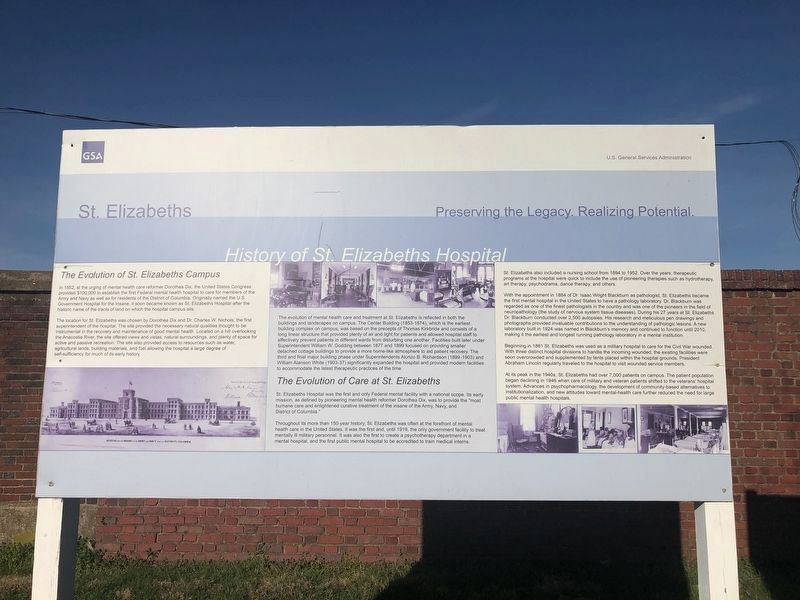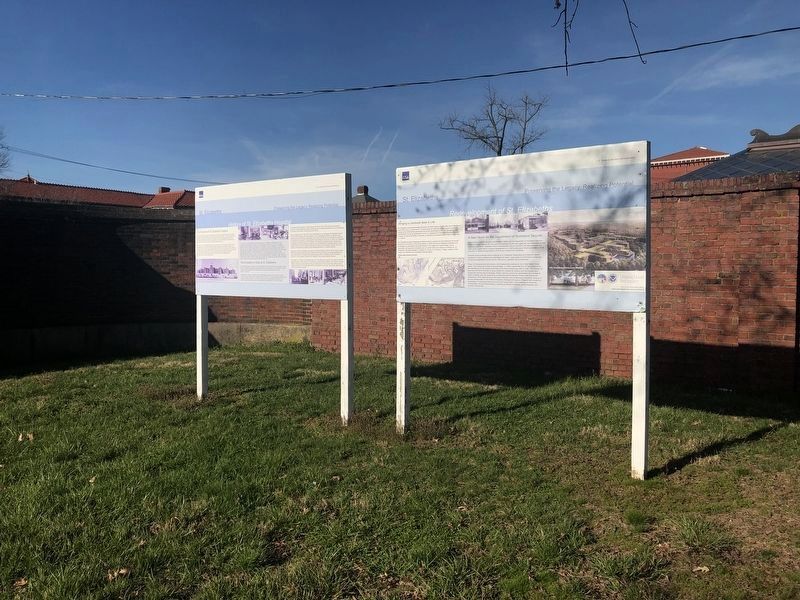St. Elizabeths in Southeast Washington in Washington, District of Columbia — The American Northeast (Mid-Atlantic)
History of St. Elizabeths Hospital
St. Elizabeths
— Preserving the Legacy. Realizing Potential. —
Evolution of St. Elizabeths Campus
At the urging of mental health care reformer Dorothea Dix, the United States Congress provided $100,000 to establish the first Federal mental health hospital to care for members of the Army and Navy as well as for residents of the District of Columbia. Originally named the U.S. Government Hospital for the insane, it soon became known as St. Elizabeths Hospital after the historic name of the tracts of land on which the hospital campus sits.
The location for St. Elizabeths was chosen by Dorothea Dix and Dr. Charles W. Nichols, the first superintendent of the hospital. The site provided the natural qualities thought to be instrumental in the recovery and maintenance of good mental health. Located on a hill overlooking the Anacostia River, the site offered views and vistas, natural surroundings, and plenty of space for active and passive recreation. The site also provided access to resources such as water, agricultural lands, building materials, and fuel allowing the hospital a large degree of self-sufficiency for much of its early history.
The Evolution of Care at St. Elizabeths
The evolution of mental health care and treatment at St. Elizabeths is reflected in both the buildings and landscapes on campus. The Center Building (1853-1874), which is the earliest building complex on campus, was based on the precepts of Thomas Kirkbride and consists of a long linear structure that provided plenty of air and light for patients and allowed hospital staff to effectively prevent patients in different wards from disturbing one another. Facilities built later under Superintendent William W. Godding between 1877 and 1899 focused on providing smaller detached cottage buildings to provide a more home-like atmosphere to aid patient recovery. The third and final major building phase under Superintendents Alonzo B. Richardson (1899-1903) and William Alanson White (1903-37) significantly expanded the hospital and provided modern facilities to accommodate the latest therapeutic practices of the time.
St. Elizabeths Hospital was the first and only Federal mental facility with a national scope. Its early mission, as defined by pioneering mental health reformer Dorothea Dix, was to provide the "most humane care and enlightened curative treatment of the insane of the Army, Navy, and District of Columbia.
Throughout its more than 150-year history, St. Elizabeths was often at the forefront of mental health care in the United States. It was the first and, until 1919, the only government facility to treat mentally ill military personnel. It was also the first to create a psychotherapy department in a mental hospital, and the first public mental hospital to be accredited to train medical interns.
St. Elizabeths also included a nursing school from 1894 to 1952. Over the years, therapeutic programs at the hospital were quick to include the use of pioneering therapies such as hydrotherapy, art therapy, psychodrama, dance therapy, and other.
With the appointment in 1884 of Dr. Isaac Wright Blackburn as pathologist, St. Elizabeths became the first mental hospital in the United States to have a pathology laboratory. Dr. Blackburn was regarded as one of the finest pathologists in the country and was one of the pioneers in the field of neuropathy (the study of nervous system tissue diseases). During his 27 years at St. Elizabeths Dr. Blackburn conducted over 2,500 autopsies. His research and meticulous pen drawings and photographs provided invaluable contributions to the understanding of pathologic lesions. A new laboratory built in 1924 was named in Blackburn's memory and continued to function until 2010, making it the earliest and longest running pathology in a mental institution.
Beginning in 1861 St. Elizabeths was used as a military hospital to care for the Civil War wounded. With three distinct hospital divisions to handle the incoming wounded, the existing facilities were soon overcrowded and supplemented by tents placed within the hospital grounds. President Abraham Lincoln regularly traveled to the hospital to visit wounded service members.
At its peak in the 1940s, St. Elizabeths had over 7,000 patients on campus. The patient population began declining in 1946 when care of military and veteran patients shifted to the veterans' hospital system. Advances in psychopharmacology, the development of community-based alternatives to institutionalization, and new attitudes toward mental-health care further reduced the need for large public mental health hospitals.
Erected by U.S. General Services Administration.
Topics. This historical marker is listed in these topic lists: Government & Politics • Science & Medicine • War, US Civil • Women. A significant historical year for this entry is 1853.
Location. 38° 51.174′ N, 76° 59.772′ W. Marker is in Southeast Washington in Washington, District of Columbia. It is in St. Elizabeths. Marker is at the intersection of Martin Luther King Jr. Avenue Southeast and Redwood Street, on the right on Martin Luther King Jr. Avenue Southeast. Near Gate 2 of St. Elizabeths campus. Touch for map. Marker is at or near this postal address: 2701 Martin Luther King Jr Avenue Southeast, Washington DC 20032, United States of America. Touch for directions.
Other nearby markers. At least 8 other markers are within walking distance of this marker. Redevelopment of St. Elizabeths (here, next to this marker); St. Elizabeths Hospital (approx. 0.2 miles away); The Curative Powers of Nature (approx. 0.3 miles away); Grandpapa's Farm (approx. 0.4 miles away); Hillsdale (approx. 0.4 miles away); St. Elizabeths Hospital Civil War Cemetery (approx. 0.4 miles away); Campbell African Methodist Episcopal Church (approx. 0.4 miles away); Barry Farm Dwellings (approx. half a mile away). Touch for a list and map of all markers in Southeast Washington.
Credits. This page was last revised on January 30, 2023. It was originally submitted on March 28, 2019. This page has been viewed 287 times since then and 36 times this year. Photos: 1, 2. submitted on March 28, 2019.

